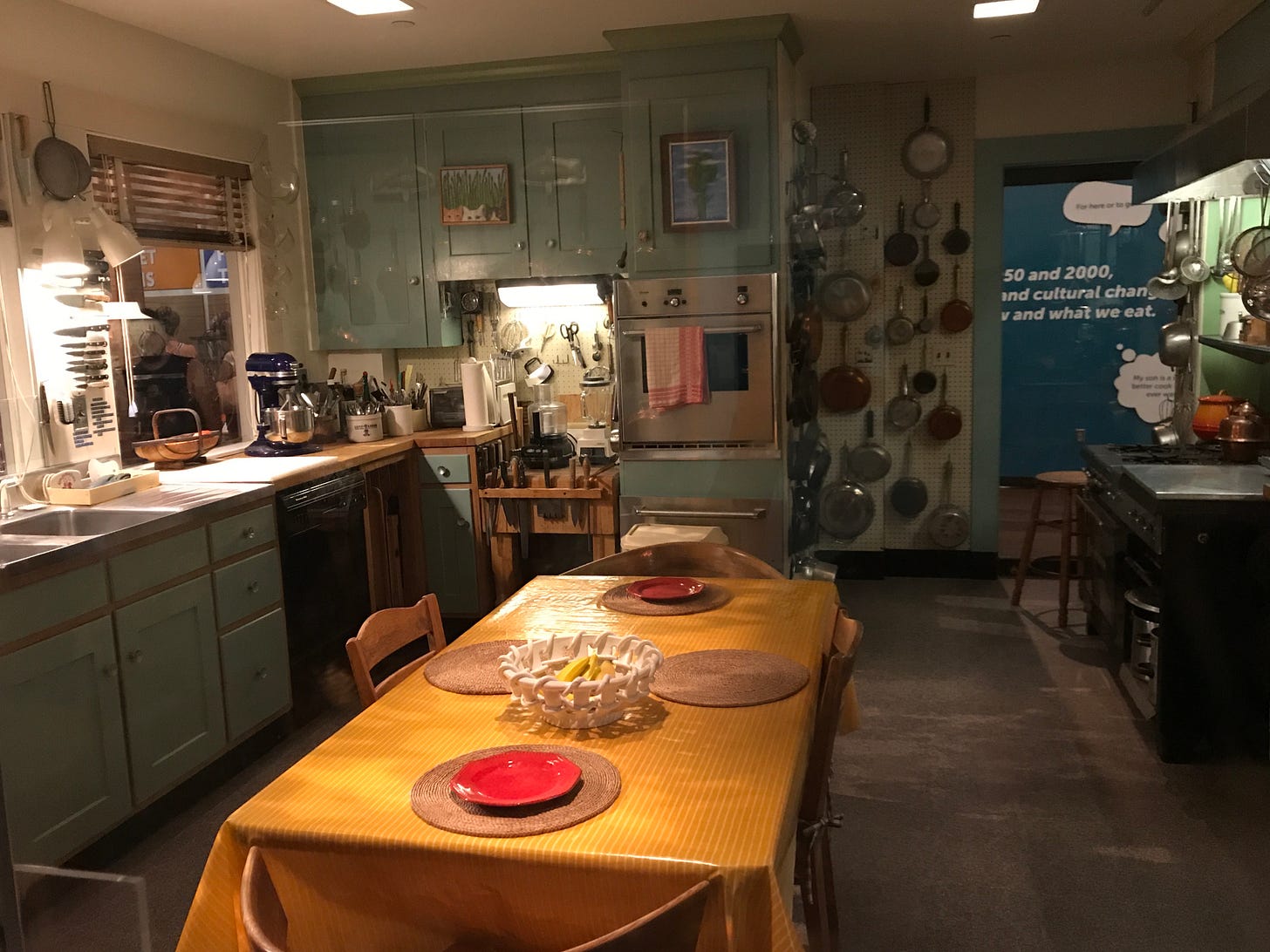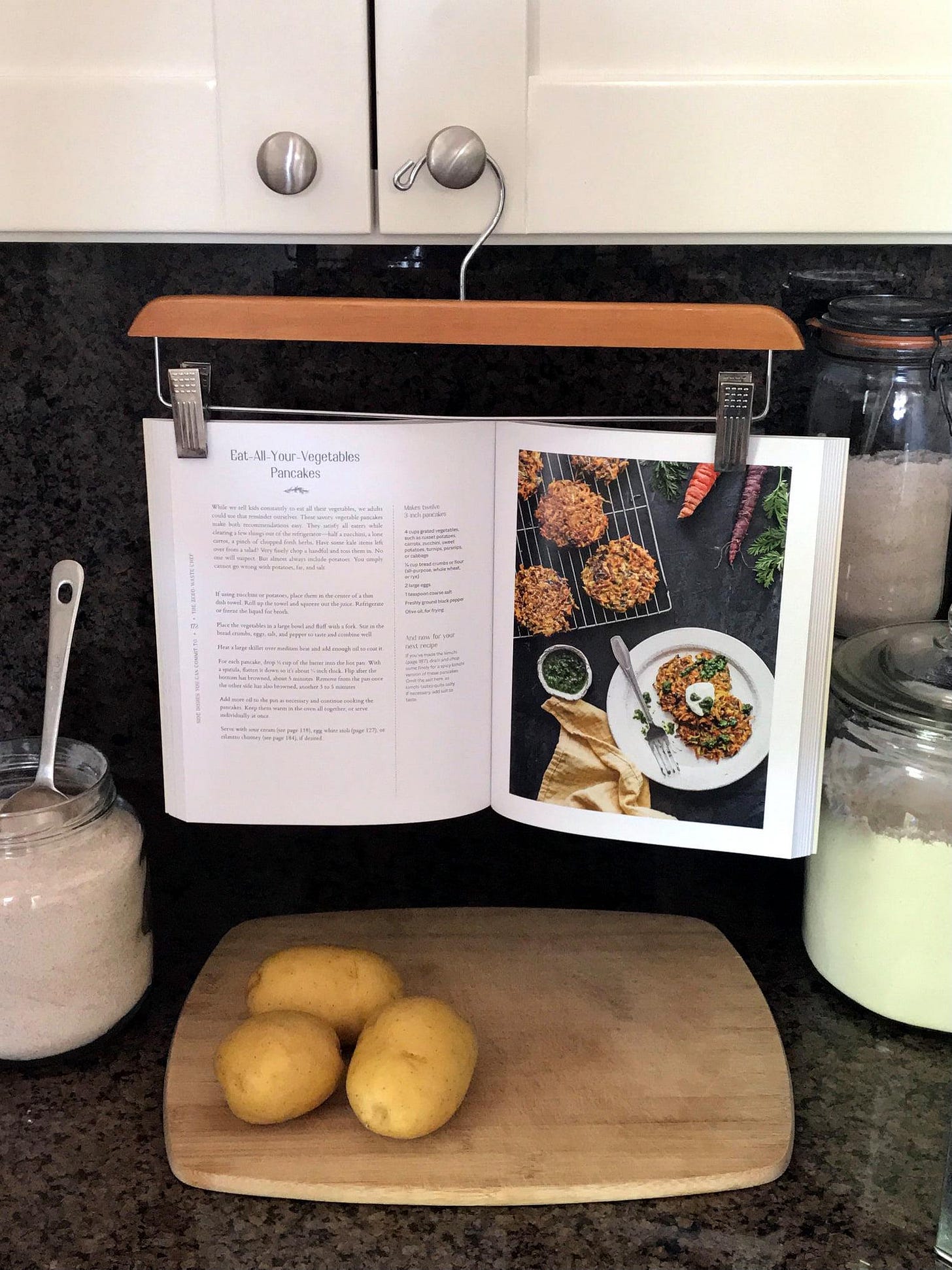If you want to eat tastier food, improve your health, cut down on your waste, reduce your dependency on corporations to feed you, spend more time with your family and save money, then cook. I know cooking does take time. These tips will help you save some.
1. Cook with what you have on hand
I cook a lot of one-pot dishes and other simple, adaptable recipes—soup, dal, frittata, pizza, fried rice, savory or sweet galettes and so on—with the food I have on hand. Because I cook the food I have already purchased before buying more, I don’t waste any. I spend less time shopping, not to mention, less time dealing with spoiled, smelly food.
Time saved: varies. Cooking with what’s on hand helps put off shopping for another day (at least), so let’s say that saves 30 minutes a week. (All of these tips vary in the amount of time saved.)
2. Keep a running shopping list and stock up on staples
When I run out of a staple—rice, beans, sugar, salt, baking soda and so on—I add it to my running shopping list and when I replenish these staples, I buy lots. (However, only buy large quantities if you’ll eat it all.) I hate to realize just as I start cooking that I’ve run out of an important ingredient. A well-stocked pantry will prevent last-minute, time-sucking trips to the store.
Time saved: varies. Making a list as you go can save about 15 minutes as opposed to searching through the cupboards and writing a list from scratch. By keeping staples stocked, you’ll also avoid last-minute trips to the store, which can easily gobble up 30 minutes or more.
3. Don’t peel vegetables
You’ll save time peeling and disposing of the peels. However, you may want to avoid produce that has been treated with synthetic pesticides since the peels can contain more pesticide residues, depending on the crop. (Go here for easy, inexpensive, DIY produce wash that can remove some pesticides.)
Time saved: you guessed it… varies. Let’s say 10 minutes per meal if you’re a heavy peeler.
4. Double or triple recipes
Cook a vat of soup, you can eat it all week and freeze some of it to enjoy later. Making twice as much doesn’t usually require twice the effort effort and will save you lots of time in the long run.
Time saved: At least an hour per vat of a dish.
5. Start early
Do what you can early and you won’t feel so daunted later when you’re tired or rushed.
For example, I love steel-cut oats for breakfast. Before bed, I heat them with water in a pot, and after everything comes to a boil, turn off the heat immediately and cover the pot with the lid. In the morning, I simply heat up the cooked oats. If I forget to do this, cooking steel-cut oats takes about 40 minutes to cook in the morning. I don’t have 40 minutes in the morning.
To save more time, test out tip #4, cook double or triple the usual amount of steel-cut oats, refrigerate the leftovers and enjoy reheated oatmeal for several breakfasts.
Time saved: 25 minutes per batch (and more if you try the cook-a-vat-eat-all-week trick).
6. Turn up the pressure
I’m obsessed with my simple pressure cooker. I bought it second-hand at the thrift shop. I don’t have an Instapot but I know people (like my sister and daughter) love theirs.
I can cook chickpeas in minutes in my pressure cooker and they taste spectacular. While they also taste very good cooked in a pot on the stove, that can take an hour, plus I have to check on them regularly, stir them occasionally, top them up with water if necessary… Of course, opening a can requires even less time than cooking dried beans but the taste can’t compare. You’ll save money too.
I cook grains and large hard vegetables in my pressure cooker as well. A whole sugar pie pumpkin cooks in eight minutes of full pressure. Beets cook about as quickly. (Read more about my pressure cooker here.)
Time saved: 30 minutes per pot of beans.
7. Use a crockpot
I don’t cook that much in my crockpot now that I have my pressure cooker but I do still use it for making stock. I have made great minestrone soup in it too. You just toss everything there and let it sit all day.
Time saved: Let’s say 30 minutes for a dish because of the hands-off nature of crockpot cooking.
8. Choose the right tool for the job
Using a bowl or pot that can barely contain its contents leads to frustration, possibly a big mess and likely extra dishes when you finally grab the right size bowl or pot. Similarly, a sharp knife will not only make chopping quick, it will help keep your fingers intact—dull knives can slip and cut you.
Time saved: varies.
9. Organize a mise en place (“put in place” en anglais)
Before you start to cook, chop and measure out everything and arrange it on your countertop. Then just grab what you need as you cook.
Time saved: Varies but easily 15 minutes for a meal because you won’t have to literally put anything on the backburner in the middle of cooking while you hunt around for ingredients or wash tools.
10. Organize your tools
I took the picture below of Julia Child’s kitchen at The Smithsonian a few summers ago. Her kitchen resembles a workshop, with easy access to equipment arranged on the walls. This kind of arrangement may not appeal to my readers who favor a more minimalist look but having even some of your favorite tools organized similarly can save you time searching for them.
Time saved: I’ll clock this one at 20 minutes saved per week hunting for stuff.
11. Prep what you can in advance
When I come home from the farmers’ market on the weekends, I prep at least a few things. I clean and store my greens (this prevents them from going limp in less than a day), I might roast a bunch of vegetables, or clean berries and freeze a bunch of them to eat or bake with later. I try to get at least somewhat organized for the upcoming week so my weekdays run more smoothly.
Time saved: A bunch of prep done at once can easily save half an hour a week.
12. Keep your compost bowl close by when prepping
This helps keep your countertop clean and organized. If you don’t compost, here’s a post on how to do it the lazy way.
Time saved: a few minutes per meal.
13. Heat water up in a kettle while you prep
When I make dal, I sometimes boil water in my kettle while I’m prepping the vegetables and then pour the ensuing hot water in my pot when needed (and make more tea while I’m at it). This speeds up cooking.
Time saved: 5 to 10 minutes per pot of food.
14. Cook more food while you have the oven on
If you’re making, say, eggplant parmigiana at 350°F, consider baking a pie or cobbler or cookies (or something savory) while you’re at it.
Time saved: varies. Per pie, you’ll save 15 minutes waiting around for the oven to heat.
15. Clean as you go
Every good cook knows this rule. Clean as you cook and you won’t face a sink piled high with dishes when you finish. While I wait for water to boil for my tea, I’ll wash a pot or pan in my efforts to keep on top of the mess.
Time saved: you guessed, it… varies.
16. Use a kitchen timer instead of your phone’s timer
This tip depends on how distracted you become when you pick up your phone. If I reach for my phone to turn off the insistent alarm and I see a notification, my vortex-like device sucks me in. So I use either the timer on the stove or my daughter’s mechanical timer.
Time saved: from a few minutes to an hour per recipe.
17. Crack open a cookbook
Okay, I do post recipes online but I try to keep my devices out of the kitchen when I cook and prefer to use cookbooks (I have written one of those too). If I want some background noise, I (usually) listen to an old-fashioned radio instead of something online. As I said, devices distract me way too easily.
Time saved: from a few minutes to an hour per recipe. Again, this depends on your appetite for distraction. During the pandemic, mine has been fairly bottomless.
Just how did I arrive at my 5 hours in the headline?
Depending on your phone habits and personality, using a mechanical or oven timer instead of your phone timer can prevent a couple of hours (or more) per week of mindless, distracted scrolling.
Cooking with what you have on hand once a week can save easily 30 minutes in shopping, shlepping and dealing with wasted food.
Cooking with a pressure cooker can save 30 minutes if you ordinarily use a pot on the stovetop.
Tripling two recipes and freezing the extra food to enjoy later will save a couple of hours at least.
So there you go—5 hours saved with just four tips alone.
Upcoming online events!
Thurs, Aug 26, 5 pm PT: Free ChouAmi Fermentation Webinar
I’ll demonstrate how to make scrap beet kvass, sour cream and creme fraiche and share waste-reducing tips. Go here for more info and to register.
Tues, Aug 31, 12 pm PT: Action Party
We’ll meet on Zoom, socialize, then contact our Members of Congress to urge them to take bold action on climate. Read more about the event and register here.
Weds, Sept 22, 5 pm PT: PCC Community Markets, Sourdough Starter and Sourdough Discard Vegan Chocolate Cake
I’ll demonstrate how to start, nurture and feed a sourdough starter and also make a vegan chocolate cake using some of the discard from feedings. Go here for more info and to register.
If you ordered my cookbook, first of all, thank you very much. I hope you are enjoying it. If you ordered it from Amazon, will you please write a review? (Goodreads also works!) Thank you for your support!





I've started doing some of these lately, along with meal planning once a week. Even the basics like having a shopping list stuck to the fridge and a pencil beside it so I can note things as I go helps. But there are definitely some new things to think about here.